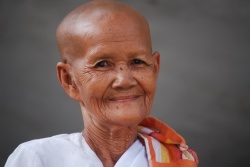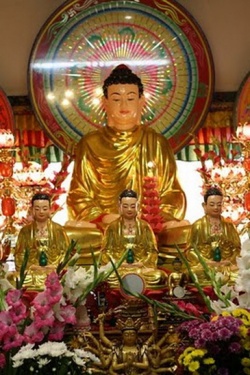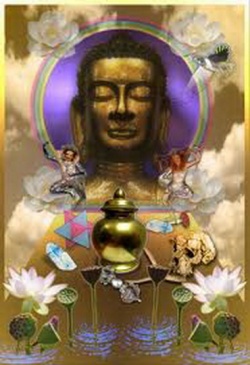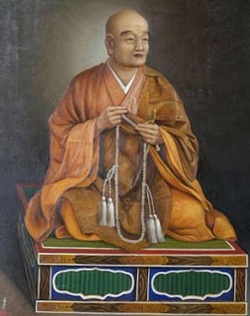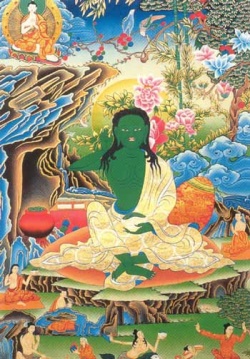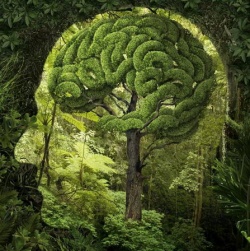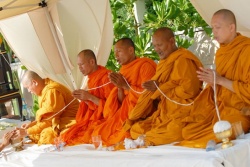Theravada Buddhism and modernization: Anagarika Dhammapala and B.R. Ambedkar (leaders of Buddhist revival in Sri Lanka and India)
The Twentieth century saw a revival of Buddhism in Sri Lanka and India. In both countries Theravada became an instrument for modernization though it played different roles in social transformation and political action in the two countries. The Buddhist revival in Sri Lanka, led by Anagarika Dhammapala (1864-1933), began as a "spin-off" from the organizational impetus provided by the Theosophical movement. In India Dr. B.R. Ambedkar (1928-1956) turned to Buddhism in his search for an alternative cultural identity for millions of his followers (particularly the Mahar caste) in his rebellion against Hinduism, its caste system and its concomitant, the institution of Untouchablity. Though Buddhism provided an institutional/cultural reference for both Dhammapala and Ambedkar, the two found inspiration and significance from it toward different ends.
The search for modernization and a reaffirmation of religious identity were two powerful forces in the making of Twentieth century South Asia. The impetus for modernization came from the Western impact ushered by British role. British role imposed on the sub-continent an imperial unity through a sub-continental centralized administration, a quasi-modern education system which created an English-speaking middle class espousing liberal values, a unified judicial system based on ideas from Anglo-Saxon jurisprudence (especially equality under law and evidential procedure), a modern transportation and communication system leading to varying degrees of spatial and social mobility and a modern military apparatus under-pinning the imperial superstructure. The idea of nationalism and aspirations for social and economic transformation were two of the more powerful aspects of the modernizing process in the two countries.
We may briefly discuss the concept of modernization and its relevance in the South Asian context. Modernization and Westernization have often been as interrelated, if not inter-changeable terms in their effects though it is also assumed that modernization need not always mean Westernization (the case of Japan being the most obvious). The modern Western ethos was based on the legacy of Greece and Rome, the Judeo-Christian tradition, the Enlightenment ideas of natural rights of man and representative (if not necessarily responsible) government and technological advances ushered by the Industrial revolution. Of these the first two had little relevance for most non-Western societies. The last two, however, were accepted as signs of progress. Increasingly, therefore, modernization became an acceptable working concept for the struggle against Western economic and political domination. When precisely the modernization process began in the West is a matter of argument. Many would assign the beginning of the modern age in Europe with the fall of the Ancien Regime and the beginning of the French Revolution in 1789. Others would extend it back to the Renaissance and the Reformation and the enlightenment of the pre French Revolution period (Bacon, Rousseau, Voltaire, the Encyclopaediasts et al.). In general it is suggested that the Modern Age has a background of at least 300 years, if not more, and leading European nations, France, England and Germany, as also the United States, had completed their modernizing process by the 1880's. In contrast countries of Eastern Europe, Latin America, Africa and Asia belonged to the pre-modern phase of human history. These roughly correspond to the modern developed and developing or underdeveloped regions of the world.
This difference, implicit in the terms referred to above, is reflected in a variety of meanings associated with modernity or modernization. Economists, sociologists/anthropologists, political scientists and intellectual historians stress one or other aspects in the context of their special disciplines. For economists modernization means capitalist industrialization and a society's ability/capacity to apply scientific technologies to channel and optimize material resources. Sociologists stress urbanization, emergence of class structures able to assume new functions and "modernize" stratified traditional social structures to undertake new roles. For the political scientist it means adoption of ideas of the rights of man and forms of representative government. For the intellectual historian modernity is synonymous with the acceptance of the primacy of human reason, a secularized social milieu within a secular state, natural rights of man and checks and balances in governmental systems, in effect a transformed assemblage of values and institutions emboding these ideas.(1)
The need for modernization was a response to European political and economic domination seen as a result of modern technologies. The major sentiment was of a desire for a sovereign native government free of foreign economic and political control. There was also a perception of challenges to the sanctity and authority of indigenous religious, social and cultural values posed by the Christian Missionary activities and the new "rationalistic/humanistic" liberal ideas. These particularly affected the established religious/social/cultural hierarchies in non-Christian lands. The emerging nationalism in India and Sri-Lanka sought to reaffirm the validity of traditional religious/cultural world-views even while accepting the need for changes in processes of learning and knowledge based on "modern" scientific knowledge and technical know-how for ensuring industrial and economic progress and "sovereignty".
Reform and reaffirmation, thus, became parts of a symbiotic process of renewal. The challenge of Christian missionary activity mainly concerned forms of articulation of traditional religious concepts and their ritual co-relates. The Christian missionary critique of traditional Hindu and Buddhist religious ideas and their validating rituals touched the core of the two Weltanchauungen. Science and technology and the role of reason in social arrangements were felt as expedient and essential for modernization. The Christian challenge, it was felt, had to be met through reform and revival. The reform movement led by Raja Ram Mohan Roy (1772-1833) was both a movement for reform and reaffirmation of Hinduism. The Theosophical movement (in its eclectic outreach) helped this reaffirmation. The alliance of Theosophy and Hinduism in India and Theravada Buddhism in Sri Lanka and its role in the emergent phases of Indian nationalism (Msr. Annie Beasant - 1847-1933 - and her Indian followers in India and Anagarika Dhammapala in Sri Lanka) is a case in point. For theosophy, association with religious movements led by leaders such as Swami Dayananda Saraswati (1824-1883) and his Arya Samaj, and with traditionalist Hindu nationalists - Pandit Madan Mohan Malaviya (1861-1946) for instance - became a convenient means for its acceptance by the elites in India. It is interesting to mention here that both Motilal Nehru (1861-1931) and his illustrious son Jawaharlal (1889-1964) were very close to the leaders of the Theosophical movement in India in its early formative years. In Sri Lanka the public recitation of the tisarana (the threefold refuge in the Buddha, Dhamma and Samgha) and the pancahsila (five precepts for Buddhist lay men and women) by Madame Helena Petrovna Blavatsky (1831-1891) and the American Colonel H.S. Olcott (1832-1907) on May 21, 1880 inspired the Buddhist revival.
Reform and revival which lay at the bases of emerging nationalism in South Asia played a significant role in the social and political history of the times. The Theosophical movement, the Arya Samaj and the Aligarh Muslim movement began in the same year (1875), indicating the resurgence of a new religious awareness in the last quarter of the Nineteenth century. Both the Arya Samay and the Aligarh movement reflected a powerful urge among the Hindu and Muslim elites to reform and reaffirm traditional religious paradigms in their quest for modernization. Such was also the case with the Sri Lankan elites in the Theravada fold. For Ambedkar revolt against traditional Hinduism and a quest for a new religious-cultural identity as a part of the "modernization" of the submerged masses of "untouchables", Buddhism became the leitmotiv six decades later. An exploration in the role of Theravada in the process of reform and reaffirmation in the careers of Anagarika Dhammapala in Sri Lanka and B.R. Ambedkar in India is the purpose of the present paper.(2) By the 1860's Buddhism in Sri Lanka had lost a good deal of its sheen and elan in Sri Lanka. The Lankan monastic order functioned more as a matter of traditional form than a vigorous and inspiring conviction and energy of its former days. The old scholarly tradition lived only in its former shadow, and the generality of the monks, it was felt, was "intellectually and spiritually moribund; monastic discipline was lax, the practice of mediation had been neglected and then forgotten; and even to those who truly loved the Buddha, the Dhamma and the Samgha, it must sometimes have seemed that, after reigning for more than twenty glorious centuries over the hearts and minds of the Simhala race, they were doomed to be cast as rubbish to the void".(3) Centuries of foreign rule, first Portuguese, then Dutch and finally British, had seemed to smother the Simhalese spirit for everywhere the West was triumphant. Simhalese Buddhist children bore Christian names and went to Christian missionary schools. It looked as if the West would finally overwhelm Buddhism and it Simhalese culture.
At this point there was a sudden stirring, a new awakening which, by the end of the century, would burgeon into a powerful Buddhist revival and, with it, Simhalese culture. Its leader was Anagarika Dhammapala.
Dhammapala's life falls into three well-marked phases. During the first phase (1864-1884) he divided his time between his involvement in the Theosophical movement and the emerging Buddhist revival. The second phase (1885-1926) saw his emergence as a powerful spokesman and the leader of the new Buddhist movement. The last (1927-1933) meant years of ceaseless effort and fulfilment in the Buddhist cause, his failing health and ordination into the order of Buddhist monks. These three phases paralleled developments in Simhalese nationalism in an almost consanguinous and symbiotic relationship.
II
Dhammapala (David) was born on September 17, 1864, in the Pettah area of the capital city of Colombo. He was the son of Don Carolis and Mallika Hewavitarane. Don Carolis belonged to the Goyigama caste which had claims to a "past lordly status in Ceylon".(4) The first noteworthy member of the family was Hewavitarane Dingiry Appuhamy. Of his two sons the older became a Buddhist monk whose tutor was fourth in pupilary succession of Samgharaja Saranakara, a renowned name in eighteenth century Simhalese Buddhism. The other son, Don Carolis, was successful businessman in Colombo. Don Carolis was an ardent Buddhist as was his wife Mallika, daughter on another prosperous Sri Lankan businessman whose connection with Buddhism was even more illustrious. He had donated a piece of land whereupon rose the later celebrated Vidyodaya Pirivena led by Hikkuduwa Siri Sumangala Maha Nayaka Thera, one of the monastic leaders of the new militant Buddhism of the 1870's and 1880's. This Buddhist heritage had a decisive influence on Dhammapala's choice of a career and his dedication to it once the choice was made. Two events presaged the emergence of a new Buddhist spirit of which Dhammapala became an inspirational spokesman. The first was the Pannadura debates between Christian missionaries and two Buddhist leaders, Hikkuduwe Siri Sumangala and Hugetuwatte Gunanada. Gunanada was the incumbent at the Kotahena temple which Dhammapala often visited. The learning and oratorical skills of Gunanada revived Buddhist confidence. The second was the arrival of the Theosophical movement in Sri Lanka and the recitation of the Buddhist tisarana and panchasila by Blavatsky on May 21, 1880, as mentioned earlier. The Theosophical movement, which Dhammapala joined so enthusiastically, gave him organizational experience so essential for the structuring of the new Buddhist movement.
Between 1864 and 1880 young Dhammapala went to a number of schools, Catholic or Anglican. The overly sectarian Christian instruction in these schools troubled Dhammapala's Buddhist convictions and led to a prolonged and often polemical encounter between the new Buddhism and Christian missions. After his formal schooling Dhammapala found employment in government service until 1886 when he gave up his job to participate in the activities of the Theosophical movement which, along with his loyalty to Buddhism, moulded his later career. In 1886 Dhammapala became the General Secretary of the Buddhist Theosophical Society and the manager of the Sandaresa periodical. During 1886-1890 he was deeply involved in a variety of Buddhist activities. In 1891 he visited Sarnath (where the Buddha preached his first sermon and Buddhism was born). He also visited Bodhagaya (where the Buddha was Enlightened). At both places he saw the plight of two of the holy places of Buddhist pilgrimage which led him to spend the rest of his life in restoration of the sites. During 1891 he also visited Burma. In May 1891 he started the Mahabodhi Society which was to become a powerful instrument in his mission for the revival of Buddhism in India and Sri Lanka. In January 1892 he started the Mahabodhi journal. In 1893 he attended the Chicago Parliament of Religions as a representative of Theravada Buddhism: it was at this meeting that Swami Vivekananda (1863-1902) emerged as a spokesman for the new Hinduism. Thereafter Dhammapala visited Japan, China and Thailand. These international appearances established his leadership in the Buddhist revival movement. The periodicals Sandaresa and the Buddhist (started in 1888) preached economic progress and the revival of the Buddhist ethos. They were widely supported by the mercantilist elements. The alliance of the business community and traditional elites, incorporating ideas of economic and political modernization in the new Buddhism, made it the vanguard of Simhalese nationalism. It reaffirmed the essentials of Theravada ideas but also suggested the need for the reformulation of aspects of religious practice to address concerns of modernity.(5)
Dhammapala also sponsored the opening of Buddhist schools to counter Christian missionary propaganda and instil in the younger generation a sense of pride in Buddhism and Simhalese culture. In his numerous speeches he dwelt on the grand theme of the necessity for reviving Buddhism which was now increasingly identified with Simhalese nationalism.
His activities in the cause of the restoration of Sarnath and Bodhagaya and other Buddhist holy places won him international attention and support. He visited England four times (1893, 1897, 1904 and 1925-1926), the U.S. six times (1893, 1896, 1897, 1902-1904, 1913-1915 and 1925), China, Japan and Thailand (1893-1894) and France and Italy en route on his journeys to England and America. During his visits to England and America he secured valuable financial support and established a Buddhist centre in London in 1926.
In India Dhammapala's efforts to restore Buddhist places of pilgrimage continued in spite of frustrations and it was not until 1930 that he was able to complete the major part of his mission. In between his stints in India Dhammapala spent his time in Sri Lanka where in 1922 he travelled across the country in the cause of national revival. His activities drew adverse British attention in India and Sri Lanka as his activities were suspected of sedition. In 1916, in the aftermath of the Buddhist-Muslim riots of 1915, he was confined to Calcutta and barred from visiting Sri Lanka, the order being rescinded in December 1919. His ceaseless travels, speeches and literary and religious work soon began to affect his health. Even during his travels in the West he suffered from fever and complained of ill-health. He reports in the Journal that he often had restless nights and disturbing dreams. He visited Sri Lanka for the last time in 1931 and on his return to India received his final ordination followed by his upasampada (confirmation as a monk) on January 16, 1933. He lived another three months and passed away on April 29, 1933 at Sarnath. His last words were: "Let me be reborn . . . I would like to be born again twenty-five times to spread Lord Buddha's Dhamma".(6)
Dhammapala has become a legend in the history of Simhalese nationalism. A passage in the St. Louis Observer of September 21, 1893 describes him thus: "with black curly locks thrown from the broad brow, his clean, clear eyes fixed upon the audience, his long brown fingers emphasizing the utterance of his vibrant voice, he looked the very image of a propagandist, and one trembled to know that such a figure stood at the head of a movement to consolidate all the disciplines of the Buddha and to spread the light of Asia throughout the civilized world".(7) Dressed in white garments, his lean and lanky figure, intense look and restless hands, projected an impressive personality wherever he went. He spoke directly and often bluntly, his passion tempered by his humility and spiritual presence. Unwavering in his faith and tireless in his work Dhammapala became a powerful spokesman for the new Buddhism breaking through its decades of isolation, poised to transform the Simhalese mind.
Dhammapala's central concern for nearly half a century (1986-1933) was Buddhism. There were three aspects in this concern. One was that of a Simhalese patriot and modernizer. The other was his concern for the condition of the places of Buddhist pilgrimage in India. The third related to his being the spokesperson for Buddhism in the West and Asian countries. These roles complemented each other and formed his vision for a revived Buddhism as the major instrument for a new Sri Lanka. His work in India and the West had largely a contemporary significance. His role as a Buddhist spokesperson melded felicitously into the growing interest in Orientalism. His impact on Sri Lanka was much more powerful and enduring. He made Buddhism self-confident as an instrument for the reaffirmation of the Simhalese cultural identity for elites as well as masses. He worked for a Buddhism that had to be different from the old reclusive creed innured in the cloistered recesses of monasteries. It had to be bold in its reinterpretations of social, economic and political agendas though loyal to the demands of the Vinaya, Sutta and Abhidhamma heritage. His Buddhism was to be a new "Protestant" creed, as called by some modern scholars but, as Dhammapala insisted, pristine in the integrity of its message for a modern Sri Lanka.
This revived and reaffirmed Buddhism was based on the innate "rationality" of the original message, "scientific" in its orientation and humanistic in its morality concerned with the demands of the "here and now" (dittheva dhamme). It had faith in man as an architect of his own destiny. It may be centuries old in its chronological age but was perennially modern in its acceptance of the scientific spirit and demands of technological change. This Buddhism, Dhammapala felt, could be the vehicle for its new pilgrimage into a modern world of economic progress and political independence.(8)
III
Bhimrao Ramji Ambedkar (1928-1956) traversed a different path in his discovery of Buddhism. The circumstances in the lives of Dhammapala and Ambedkar were so different and each arrived at his own interpretation of Buddhism in strikingly different forms. For Dhammapala Buddhism was a "given", a self-evident reality and way whose restatement and reaffirmation were parts of a Sri Lankan nationalism. For Ambedkar nationalism had already come to fruition in 1947, and he was an architect of the new nation's constitution. Political independence fo Ambedkar, however, did not mean social liberation from the schakles of the inequities of the caste system and the tyranny of untouchability which condemned millions to lifelong submergence and servitude. Though the Constitution had outlawed the practice of untouchability, its reality in a myriad of villages continued to sear the lives of its victims. The untouchables had been granted concessions but their human dignity had yet to be redeemed.
Ambedkar did not come to Buddhism until late in his life. His career and actions have an unusual significance in Indian social history. In the past a number of Bhakti - poets of Maharashtra (among whom Chokha Mela, a Mahar, to which caste Ambedkar belonged) had stood outside the portals of temples to beseech the Deity for succor against the indignities and oppression inflict on them by the upper castes led by their priests. Chokha Mela was honoured as a saint but his Mahars continued to suffer caste depredation and tyranny. Ambedkar refused to be a supplicant at the temple gates. These temples and their deities had little use for him for they had diminished, if not destroyed, the untouchables' human dignity. In this he became the first successful untouchable leader to demand justice, dignity and human rights for millions. Turning his back on the darkened recesses of the temple Ambedkar led millions of his followers into a new dawn with conversion to Buddhism. Ambedkar was born on April 14, 1891, in Mhow in Madhya Pradeh, in the Mahar caste. He was the son of Ramji Sakpal and his wife Bhimabai (nee Murbadkar). The Sakpals and Mubadkars had served in the Indian Army, then an avenue for upward mobility for the Mahars. Bhimrao received his early education in Dapoli and Satara and graduated from the Elphinstone High School in Bombay in 1907. His name was now Ambedkar variously explained as either meaning "from" Ambavade (his native village) or "gifted" to him by a Brahman school teacher. Prior to his high school graduation Bhimrao was married to Ramabai, daughter of a Mr. Walangrar who worked as a porter at Dapoli. With the help of a scholarship from the Maharaja of Baroda, Ambedkar went to Elphistone College and received his B.A. degree from the University of Bombay in 1912. Then, again with financial assistance from Baroda, Ambedkar went to Columbia University in New York in 1913 where he received his M.A. in 1915 and his Ph.D. a year later. In 1916 he was in London to become a Barrister-at-Law but as his money ran out, he had to return to India in 1917. After a brief spell in the Baroda State administration he went to Bombay to teach law and business at the Sydenham College and the Government Law School to augment his meagre earnings from his law practice. He went back to London in 1920, this time with a scholarship from the Maharaja of Kolhapur, where he completed his work for Barrister-at-Law and D.Sc. in Economics and returned to India in 1923.(9)
From Mhow, Dapoli and Bombay Ambedkar had travelled for and wide both spatially and intellectually. He scored some outstanding firsts for a member of a Hindu untouchable caste, in high school graduation, colleges and university degrees in Bombay, London and Columbia, achievements considered impossible for a member of an oppressed caste. He began his law practice in Bombay but was increasingly involved in social and political movements mobilizing the lower and untouchable castes. Between 1924 and 1949 Ambedkar played the role of a stormy petrel in Indian politics confronting great icons such as Gandhi and Nehru. He felt that Gandhi had pushed the problem of the untouchables under a capacious rug called "Harijans" (children of God). He demanded a fundamental transformation in the social philosophy and structure of Hindu society, stating that wherever there was caste there were bound to be outcasts. He had secured political gains for the untouchables through negotiations with the rulers and Gandhi (Poona Pact of September 1932). But he realized that a few and halting political concessions did nothing to change the social and economic conditions of the untouchables as a whole. Ambedkar, in spite of his illustrious academic career, his knowledge and understanding of law and his political efforts had known personal humiliation as a Mahar. He was humiliated in the elections of 1952 when the Congress Party contrived his defeat at the hands of a non-entity from one of the "scheduled" castes. The upper caste Hindus in the Congress had frustrated him but Ambedkar was not the one to meekly accept defeat and ask for forgiveness and accommodation.(10)
Since the 1930's Ambedkar was deeply exercised with the subject of interrelationships between Hinduism and current politics. The three major influences in his family life and early childhood were a) the religious ambience in his family; b) the humiliations he suffered at the hands of the upper caste Hindus as a student and a professional person and c) his six-plus years spent in the West. Each of these shaped his thinking and defined the nature of his responses to religion and politics in India.
His familial religious affiliation was with the Kabir Panth named after Kabir who lived during the last quarter of the Fifteenth and the opening decades of the Sixteenth centuries (tradition asserts that Kabir died in AD 1518). Kabir was a disciple of Ramananda, the founder of the Bhakti movement. Kabir was a rebel who attacked the caste system and religious divisions and preached a doctrine of loving devotion to the One and Loving God. The influence of the Ramananda-Kabir Bhakti marga (path) continued through much of Ambedkar's life.
If Bhakti attracted Ambedkar, so did the Sanskrit language. But Brahmanical arrogance prevented him from learning the language then regarded as the sole preserve of the Brahmans. All of this created in him an uncompromising hostility to Hinduism. In 1948 he called Hindu civilization an "infamy". For him what was defining in the Hindu tradition was not the lofty metaphysics of the Vedanta which identified the individual being with the Supreme but its social doctrines enshrined in law codes such as the Manu Smriti which he ceremonially torched in 1927.(11) Ambedkar had lost his patience with faith in Hinduism for he doubted its ability to change its social thinking and accord human dignity to millions who so pathetically hovered at the fringes of Hindu society.
By the 1930's Ambedkar had begun to turn his back on Hinduism with its chaturvarna (four "orders" which Gandhi accepted implicitly) as a determinant in a system of division of social labour turning millions of the panchamas (outcastes) into "invisible" humans. Hinduism had not known genuine Reformation and its Renaissance was much like a rediscovery of a long lost Brahmanical past. The ruling caste hierarchies of the Brahman and intermediate castes (such as the Maratha castes in Maharashtra and Yadavs in northern India) had a vested economic and social interest in keeping the untouchables in their "place". His Western experience had given him a taste for the thrust and parry of rational thought and the power of ideas in bringing about far-reaching social change. Hindu leaders, he felt, were more interested in preserving their political and economic power than in bringing about much-needed change in social thinking and behaviour.(12)
The failure of the Hindu hierarchy in meaningfully helping the submerged masses climb out of their state of degredation and despair made Ambedkar pessimistic about the future of the untouchables in Hindu society. At a conference at Yeola (Nasik distinct in Maharashtra) he declared, more in sorrow that anger: "It is an unfortunate fact that I have been born a Hindu; it was not in my hands or change that. But I can say this with utmost gravity and sincerity: I will not die a Hindu".(13) With this he put the Hindus on notice that he was not a pity-mongering supplication of a Choka Mela but a revolt against a faith and its social system that denied human dignity to millions. He had begun a search for a faith that would empower the untouchables to be human beings in their own right.
Ambedkar had won for the untouchables a few economic and political concessions and a possibility of functioning as a "pressure group" in the game of party politics. He differed fundamentally from Gandhi in matters of economic and social thinking. Gandhi was skeptical of the benefits of "modernization". He denounced industrialization as heartless and exploitative. He preached a return to a romantically idealized village society. Ambedkar had grown out of that society and the reality of that society was far from idyllic. For him the Indian village was dead, for decades if not centuries. What was left of it was a corpse ready for incineration or burial. For him the best course for the untouchables was two-fold, leave the village to escape the social and economic tyranny imposed by the intermediate castes and seek their destiny in the industrializing urban areas and leave Hinduism to its own devices for a new identity through another faith.
Marxism failed to attract him. His own deeply religious nature was uncomfortable with Marxist materialism and historical determinism and the Marxist reality of tyranny and suppression of dissent in the Soviet Union. He had seen the intellectual subservience of the Indian Marxists to their mentors in Russia and was wary of the Indian left-wing intellectuals and their newly discovered "secularism". He felt neither was capable of confronting the social reality of the untouchables either in their dogmas or eagerness to play "operational" politics in the Indian context.
His decision to leave the Hindu fold in 1935 led to a virtual "conversion" stampede. Muslims, Sikhs, Christians and other sundry religious votaries raced to his door with all kinds of promises. For some of them it was a kind of a spiritual "auction" for the prize was nothing less than the winning of millions of votaries and their votes from among the ex-untouchables. He did not want his people to be mere pawns on the chess board of political ambitions. Also he knew that his followers were deeply affected by Bhakti and cherished their "Indian-ness". Islam in India had a past of invasions and fanatical suppression of non-Muslim challengers. Christianity was tainted with its association with imperialist rule and was regarded as much of "foreign" orgin as Islam.
What Ambedkar was seeking for his people was more than the removal of the formal stigma of "untouchability" and consequent economic deprivation and social degradation. He wanted for his people a new faith, a new identity based on an ethical creed and a rationalistic world-view. This, for obvious reasons, also had to be a part of the "Indic" tradition. Buddhism, it seemed to him, was such a doctrine and culture.
Buddhism, for Ambedkar was a religion of reason and compassion. The Buddha had challenged Brahmanical priestly presumption with its quasi-magical ritual and inequitous social hierarchy. Buddhism, for Ambedkar, was a basically rational creed with faith in the ability of man to be an architect of his own destiny. More than its monastic ideals and emphasis on withdrawal from the world of everyday events, Ambedkar saw in Buddhism a means for the untouchable to transcend the limitations of caste and turn toward a "modern" rationalist understanding of himself and his world. Buddhism had a glorious past in philosophy and metaphysics, literature and art, social awareness and meaningful effort in helping the individual find himself. He wanted to get away from the Hindu mansion but not alienate himself and his followers from their "Indian-ness". In a sense Ambedkar's act in turning to Buddhism rather than Islam or Christianity was his final gracious gesture toward the Hindus. He was saying that he was leaving Hinduism but not abandoning the Indic tradition. As a realist Ambedkar knew much that passed muster under the rubric of Buddhism was not without blemishes and the insistence of monastic Buddhism in its ascetic renunciation from the world was not something he favoured. He had begunn to give his own interpretation of what to him was the essential Buddhism committed to social action, economic advancement and social "modernization". The new Choka Mela had ceased imploring God to deliver him from humiliation and deprivation but was ready and willing to march into an identity of a new faith and its new distinctive culture. He had turned his back on the old temple to find a new shrine promising revitalization of the entire human being. Buddhism, thus, was not just another religion but an opportune way of modernizing and energizing a hitherto submerged and suppressed mass.
His call for conversion to Buddhism in 1956 was heeded in massive numbers. In 1951 there were 2,487 Buddhists in Maharashtra (0.1% of the population). In 1961 they were 2,789,501 (7.5%) far exceeding the numbers of Christians (1.42%) and close to that the Muslims (7.6%), Ambedkar's conversion had projected a new (14) community claiming its own distinct place under the Indian sun.(14) The careers of Dhammapala and Ambedkar point to the inadequacies of accepted notions concerning so-called world-affirming and world-negating typology in the history of world religions. Theravada Buddhism, as revealed in a scripture-focussed understanding, is a religion of world-renunciation. But its political and social thrusts are clearly revealed in historical evidence of dynastic chronicles and a mass of inscriptional material scattered across India, Sri Lanka, Burma and Thailand. Ever since its inception laymen and laywomen formed an integral and active part of the Theravada Buddhist society and the role of the men and women of the world has been no less distinguished than that of the monastic communities in the making of its world. Dhammapala espoused Buddhism as a basis for the Simhalese cultural reaffirmation; Ambedkar found in it a means for social liberation and cultural transcendence.
NOTES
1 For ideas on Modernity see Rudolph, L.I. & Rudolph, S.H., The Modernity of Tradition, Chicago, 1967, pp. 12-14.
2 For religion and nationalism see Van der Veer, P., Religious Nationalism, Berkeley, 1994, pp. 118-119; for Theosophy and Buddhism see Agarwal, C.V., The Buddhism and the Theosophical Movements, Sarnath, 1993, pp. 13 ff.
3 For an earlier version of Dharmapala and the Simhalese renaissance see Gokhale, B.G., "Anagarika Dharmapala - Toward Modernity Through Tradition" in Smith, B.L. (Ed), Contributions to Asian Studies, Leiden, 1975, pp. 30-39 for Dharmapala's life see Bhikshu Samgharakshita, Anagarika Dharmapala, A Biographical Sketch, Kabdy, 1964, p. 2.
4 For the Goyigama caste see Bryce, Ryan, Caste in Modern Ceylon, New Brunswick, 1953, p. 96.
5 Details of Dharmapala's career are based on Samgharakshita, Op. Cit., and Guruge, A., (Ed), Return to Rightiousness, Colombo, pp. XXXIII if; also see Wickramaratne, "Religion, Nationalism and Social Change in Ceylon, 1865-1885" in Journal of the Royal Asiatic Society, No: 2, 1969, pp. 135 ff.
6 Guruge, Op. Cit., pp. LXI-LXXXIII.
7 Quoted in Samgharakshita, Op. Cit., p. 62.
8 For Dharmapala and "Protestant" Buddhism see Gombrich, R. & Obeysekere, Buddhism Transformed, Princeton, 1988, pp. 13 ff, 221-227; 231-234 and passim.
9 For sources on Ambedkar's life and career see B.G. Gokhale, "Dr. Bhimrao Ramji Ambedkar: Rebel against Hindu Tradition" in Smith, B.L. (Ed), Religion and Social Conflict in South Asia, Leiden, 1976, pp. 14-16; for details see Gokhale, J., From Concessions to Confrontation, Bombay, 1993, pp. 83 ff.
10 Gokhale, B.G., Op. Cit., pp. 16-20.
11 Gokhale, J., Op. Cit., pp. 94-95, 164-165.
12 Gokhale, B.G., Op. Cit., pp. 18-19.
13 Ibid., pp. 21-22.
14 Ibid., p. 22.
15 For royal support to Buddhism see Gokhale, B.G., Asoka Maurya (New York, 1966), pp. 67 ff; and Buddhism in Maharashtra (Bombay, 1976), pp. 120 if; for inter-relations between the Samgha and the laity see Gokhale, B.G., New Light on Early Buddhism (Bombay, 1994), pp. 13-24.
16 For these views see Blackburn, A.M. "Religion, Kinship and Buddhism: Ambedkar's Vision of a Moral Community" in Journal of the International Association of Buddhist Studies, Vol. XVI, No: 1, pp. 1-23.
Professor Emeritus, Department of History and Asian Studies, Wake University, Winston-Salem, NC 27106, U.S.A. Balkrishna Govind Gokhale, Professor Emeritus of History and Asian Studies, Wake Forest University, Winston-Salem, NC, has taught for 48 years, fifteen in India and thirty three in the United States. His interest in Pali and Theravada Buddhism goes back to 1935. Among his seventeen books and 95 papers published in the U.S., Canada, U.K., France, Italy, Israel, Thailand, Sri Lanka and India, four books and some 36 papers deal with Pali literature and Buddhist history.
